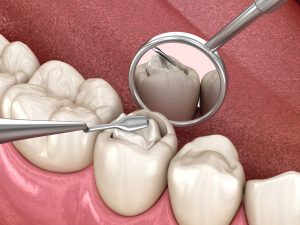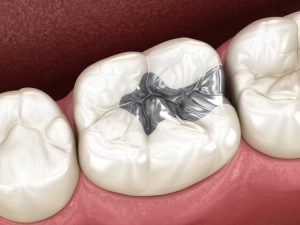What Are Dental Fillings?
Dental fillings are a restorative treatment used to repair teeth affected by decay or damage. When a tooth develops a cavity (dental caries), a small hole caused by decay, a dental filling can fill the tooth cavity and prevent further decay or infection. A dental filling can also repair teeth damaged due to trauma or wear.
With dental cavity fillings done, Dr. Nishime can help patients:
- Restore the structural integrity of the tooth, preventing further decay and damage.
- Alleviate tooth sensitivity and pain associated with cavities or damaged teeth.
- Improve the appearance of the tooth, especially with tooth-colored materials.
- Preserve the tooth’s function and aesthetics for years to come.
Types of Dental Fillings
At Advanced Restorative Dentistry, we offer a variety of dental filling materials to cater to our patients’ unique needs and preferences. The types of dental fillings we provide include:
Composite Fillings
Composite tooth fillings are tooth-colored fillings made from a mixture of plastic and glass particles. They blend seamlessly with the natural teeth, making them a popular choice for visible areas of the mouth. Composite fillings bond directly to the tooth structure, providing excellent support.
Amalgam Fillings
Amalgam fillings, also known as silver fillings, are made of a mixture of metals, including silver, tin, copper, and mercury. They’re highly durable and have been used for many years, though their silver color can be more noticeable.
Ceramic Fillings
Ceramic fillings are made of porcelain or ceramic materials. They’re tooth-colored and offer excellent aesthetics, making them a great choice for visible areas. Ceramic fillings are highly resistant to staining and are well-suited for areas of the mouth that require strength and durability.
Glass Ionomer Fillings
Glass ionomer fillings are a mixture of acrylic and glass materials. They release fluoride, which helps prevent further tooth decay. Glass ionomer fillings are often used in children or for non-load-bearing areas of the teeth.
Gold Fillings
Gold fillings are made of gold alloy, which is a mixture of gold and other metals like silver and copper. They’re highly durable and can last for many years. Gold fillings are custom-made in a dental laboratory and are more expensive compared to other types of fillings.
Benefits of Dental Fillings
Dental fillings offer numerous benefits for oral health and well-being. Some of the advantages include:
- Decay Removal: Fillings effectively remove and seal areas of decay, preventing further progression.
- Tooth Preservation: By restoring damaged tooth structure, fillings help preserve the remaining healthy tooth.
- Restored Function: Fillings restore the ability to chew and bite comfortably.
- Pain Relief: Treating cavities and decay alleviates discomfort.
- Improved Aesthetics: Tooth-colored fillings enhance the appearance of your smile.
- Durability: With proper care, dental fillings can last for many years.
- Quick Procedure: Getting a dental filling is a relatively quick and straightforward process.
- Minimal Sensitivity: Modern filling materials and techniques minimize post-operative sensitivity.
- Prevents Tooth Fractures: Fillings reinforce weakened teeth, reducing the risk of fractures.
- Cost-Effective: Dental fillings are a cost-effective solution compared to more extensive treatments.
Do You Need Dental Fillings?
To determine your candidacy for dental fillings, Dr. Nishime and our team will evaluate the following:
- Presence of a Cavity: We’ll look for a cavity in a tooth through X-rays and a visual examination.
- Tooth Structure: We’ll assess the extent of damage to the tooth structure to determine if a filling is suitable or if alternative treatments are required.
- Overall Health: Your health and medical history will be considered, as certain conditions or medications may affect the filling material or the procedure.
- Allergies or Sensitivities: Our team will account for allergies or sensitivities to specific dental materials when selecting the appropriate filling material.
- Adequate Tooth Structure for Support: There must be enough healthy tooth structure to support the filling. If the tooth is severely compromised, alternative treatments may be necessary.
- Patient’s Preferences: We’ll discuss your preferences, especially if there are cosmetic concerns, and recommend the best filling material for your needs.
- Budget and Insurance: Financial considerations, including the cost of the filling and your dental insurance coverage, will be discussed.
- Alternative Treatments: If a filling isn’t the most suitable option, we’ll explore alternative treatments such as dental crowns, inlays, onlays, or tooth extraction.
The Dental Filling Process
At Advanced Restorative Dentistry, we can ensure a comfortable and efficient dental filling experience.
- Dr. Nishime will start by numbing the area around the tooth to ensure your comfort during the procedure. Sedation dentistry is also available if you’re nervous or in for a long procedure.
- Next, we’ll use a dental drill or laser to remove the decayed portion of the tooth, leaving a clean and prepared area.
- Once the decay is removed, Dr. Nishime will carefully shape the cavity to create space for the filling material.
- The chosen filling material, such as composite resin, amalgam, or porcelain, is then placed into the prepared cavity and shaped to match the natural contours of the tooth.
- The filling is hardened using a curing light.
- After ensuring the proper fit and bite alignment of your newly filled tooth, we’ll make any necessary adjustments.
- The final step involves polishing the filling to achieve a smooth and natural appearance. The result is a restored tooth that’s both functional and aesthetically pleasing while preventing further decay and maintaining oral health.
How Much Do Dental Fillings Cost?
On average, a dental filling costs between $50 to $250 in Honolulu, HI. However, certain factors will affect the total cost of your filling treatment, such as the type of filling material, the complexity of your procedure, and the location of the dental practice. In most cases, dental insurance covers at least a portion of dental filling expenses.
Frequently Asked Questions
The process of getting a dental filling is usually painless. Before beginning the procedure, your dentist will administer a local anesthetic to numb the area around the tooth. This ensures you won’t feel any pain during the cavity removal or filling placement.
Some patients might experience mild discomfort or sensitivity after the anesthesia wears off, but this is temporary and can be managed with over-the-counter pain relievers.
The lifespan of a dental filling varies depending on factors such as the type of material used, the location of the filling, and the individual’s oral hygiene habits. Amalgam fillings can last for decades, while composite resin fillings might need replacement after around five to 10 years.
Regular dental check-ups can help monitor the condition of your fillings and detect any signs of wear or damage, ensuring timely maintenance or replacement if necessary.
Call Us & Restore Your Radiant Smile With Dental Fillings Today!
Dental fillings play a vital role in restoring the health, function, and aesthetics of our teeth. Whether addressing cavities, reinforcing tooth structure, or enhancing smiles, getting a filling is a routine yet essential dental procedure. If you’re experiencing any dental discomfort or suspect you might need a filling, don’t hesitate to reach out to our team at Advanced Restorative Dentistry.
Schedule an appointment today by calling our Honolulu dental office at (808) 732-0291, and take the first step toward maintaining your radiant smile and well-being. Dr. Nishime and our team are here to help patients from Honolulu, Kailua, O’ahu, Kapolei, and surrounding areas achieve optimal oral health.






